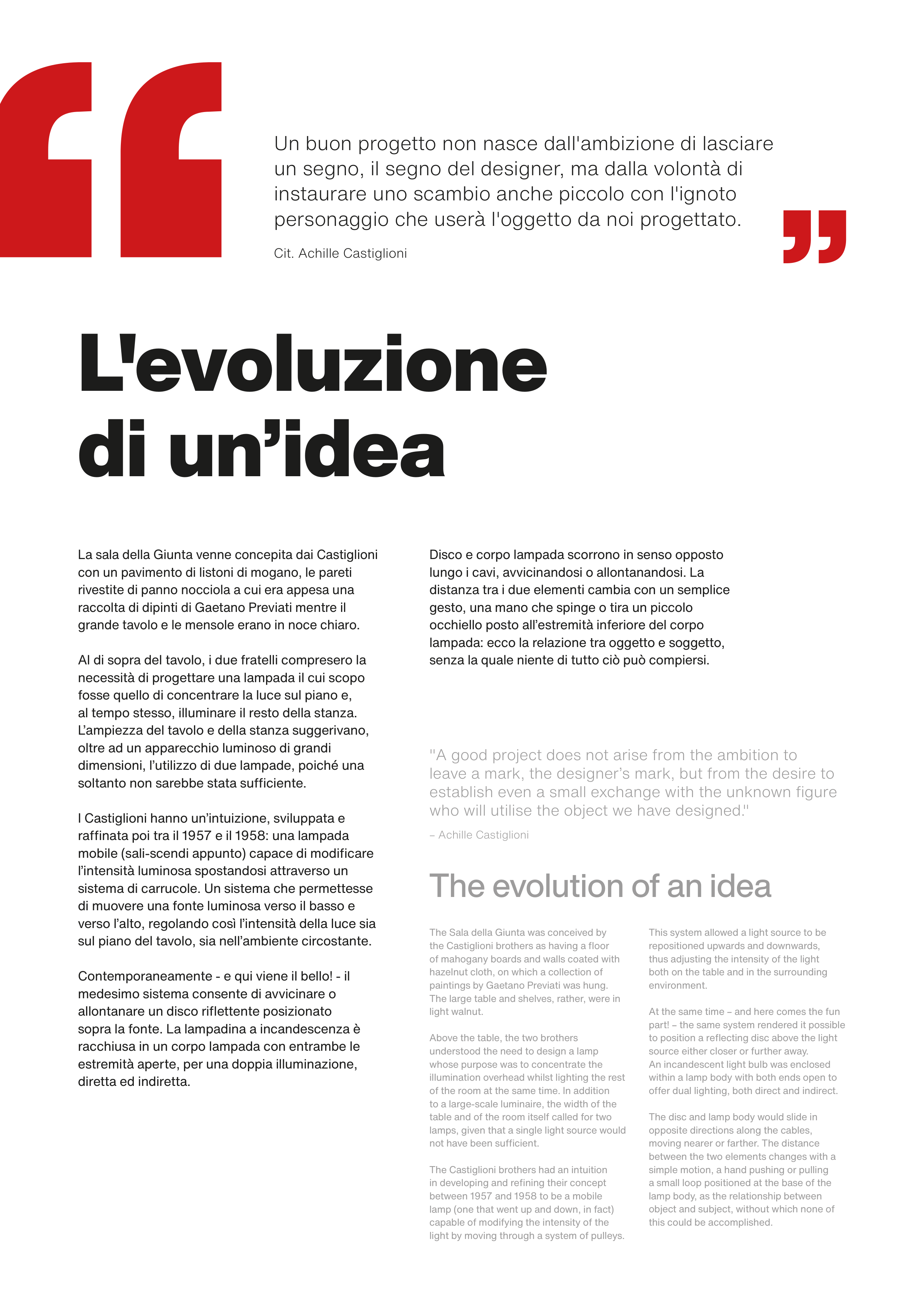L'evoluzione
di un’idea
La sala della Giunta venne concepita dai Castiglioni
con un pavimento di listoni di mogano, le pareti
rivestite di panno nocciola a cui era appesa una
raccolta di dipinti di Gaetano Previati mentre il
grande tavolo e le mensole erano in noce chiaro.
Al di sopra del tavolo, i due fratelli compresero la
necessità di progettare una lampada il cui scopo
fosse quello di concentrare la luce sul piano e,
al tempo stesso, illuminare il resto della stanza.
L’ampiezza del tavolo e della stanza suggerivano,
oltre ad un apparecchio luminoso di grandi
dimensioni, l’utilizzo di due lampade, poiché una
soltanto non sarebbe stata sufficiente.
I Castiglioni hanno un’intuizione, sviluppata e
raffinata poi tra il 1957 e il 1958: una lampada
mobile (sali-scendi appunto) capace di modificare
l’intensità luminosa spostandosi attraverso un
sistema di carrucole. Un sistema che permettesse
di muovere una fonte luminosa verso il basso e
verso l’alto, regolando così l’intensità della luce sia
sul piano del tavolo, sia nell’ambiente circostante.
Contemporaneamente - e qui viene il bello! - il
medesimo sistema consente di avvicinare o
allontanare un disco riflettente posizionato
sopra la fonte. La lampadina a incandescenza è
racchiusa in un corpo lampada con entrambe le
estremità aperte, per una doppia illuminazione,
diretta ed indiretta.
Disco e corpo lampada scorrono in senso opposto
lungo i cavi, avvicinandosi o allontanandosi. La
distanza tra i due elementi cambia con un semplice
gesto, una mano che spinge o tira un piccolo
occhiello posto all’estremità inferiore del corpo
lampada: ecco la relazione tra oggetto e soggetto,
senza la quale niente di tutto ciò può compiersi.
Un buon progetto non nasce dall'ambizione di lasciare
un segno, il segno del designer, ma dalla volontà di
instaurare uno scambio anche piccolo con l'ignoto
personaggio che userà l'oggetto da noi progettato.
Cit. Achille Castiglioni
The Sala della Giunta was conceived by
the Castiglioni brothers as having a floor
of mahogany boards and walls coated with
hazelnut cloth, on which a collection of
paintings by Gaetano Previati was hung.
The large table and shelves, rather, were in
light walnut.
Above the table, the two brothers
understood the need to design a lamp
whose purpose was to concentrate the
illumination overhead whilst lighting the rest
of the room at the same time. In addition
to a large-scale luminaire, the width of the
table and of the room itself called for two
lamps, given that a single light source would
not have been sufficient.
The Castiglioni brothers had an intuition
in developing and refining their concept
between 1957 and 1958 to be a mobile
lamp (one that went up and down, in fact)
capable of modifying the intensity of the
light by moving through a system of pulleys.
This system allowed a light source to be
repositioned upwards and downwards,
thus adjusting the intensity of the light
both on the table and in the surrounding
environment.
At the same time – and here comes the fun
part! – the same system rendered it possible
to position a reflecting disc above the light
source either closer or further away.
An incandescent light bulb was enclosed
within a lamp body with both ends open to
offer dual lighting, both direct and indirect.
The disc and lamp body would slide in
opposite directions along the cables,
moving nearer or farther. The distance
between the two elements changes with a
simple motion, a hand pushing or pulling
a small loop positioned at the base of the
lamp body, as the relationship between
object and subject, without which none of
this could be accomplished.
The evolution of an idea
"A good project does not arise from the ambition to
leave a mark, the designer’s mark, but from the desire to
establish even a small exchange with the unknown figure
who will utilise the object we have designed."
– Achille Castiglioni


